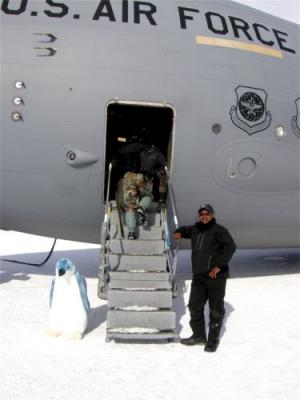"Under its worst conditions this earth is a good place to live in."
This quote, by Henry Robertson "Birdie" Bowers, exemplifies the positive attitude of many polar explorers. Bowers was one of the five men on Scott's ill-fated return from the South Pole and perished with the others. Scott, in his diary, said of Bowers: "As the troubles have thickened about us his dauntless spirit ever shone brighter and he has remained cheerful, hopeful, and indomitable to the end".
In my six weeks in Antarctica, I have seen many people exhibit positive attitudes and great work ethics. Granted, most of them will never be challenged like the early explorers were, but there are still struggles due to extreme weather and difficult logistics.
Since today is my last day in Antarctica, I wake early and try to catch the night crew processing the ANDRILL core. The crew had finished before I arrived at the lab, but Tracy Frank showed me some of the cores they had processed that night.

Tracy Frank shows me some of the cores from the ANDRILL project
The cores are split in half, and then wrapped in cellophane so they don't dry out. Half of the core is archived and the other half is analyzed for many different characteristics. Primary core processing occurs each night with about 50-60 meters of core being processed from the previous days drilling. Then there is a core showing at 10 a.m. and the various researchers from Italy, Germany, New Zealand and the United States tag where they want to sample the core more thoroughly.

Three one-meter cores

Geologists can identify rock types and analyze other parameters
Since my plane didn’t leave until noon, I checked into one more scientific experiment that is happening in the aquarium right next to our lab. Lindy Mullen and Pema Kitaeff are measuring the response time of Pycnogonids (sea spiders) to right themselves after being flipped over on their backs. They are varying levels of dissolved oxygen and the length of recovery periods between "flips". Since we use oxygen to metabolize our food for energy, you would hypothesize that low oxygen levels would make it hard for these sea spiders to have enough energy to flip over from their backs to their fronts. They are still in the early stages of their research so you will have to wait to see what results they get!

Pema (left) and Lindy are timing Pycnogonid righting behavior
In the lab today, BLee, Bob and Marcus talked about the technical aspects of the SCINI project. I don't think BLee and Bob are really sleeping, I just didn't take a very good photo!

BLee, Bob and Marcus discuss SCINI electronics
And Stacy showed Rusty the dive locker and how the diving equipment in Antarctica is different from at home in California.

Stacy shows Rusty the dive equipment
I went to the galley to get a sandwich "to go". I'm going to miss having the wonderful galley crew make all my meals and do all my dishes for me! Then Marcus and I went to catch our plane.

Josh Mueller, from the Mayo Clinic high-altitude sickness project, ready to board

A stuffed pengin and smiling crew member welcome us to the C-17
Marcus spent some time up in the cockpit of the plane on the flight back to New Zealand. It was extra exciting as he had two 2-Star Generals showing him the controls. The military is in charge of all flights into and out of Antarctica. Marcus has flown for his father’s company, so he knows a lot about planes. Plus, Marcus is one of those people that enjoys talking with and learning from everyone.

Marcus visiting with a member of the Air Force on the C-17
When we arrived in New Zealand we kept sniffing the air. There was green grass, trees, colorful flowers, and singing birds. Spring is busting out all over in Christchurch and we were so excited to see and smell the plant life after 6 weeks of snow and ice and rock!

